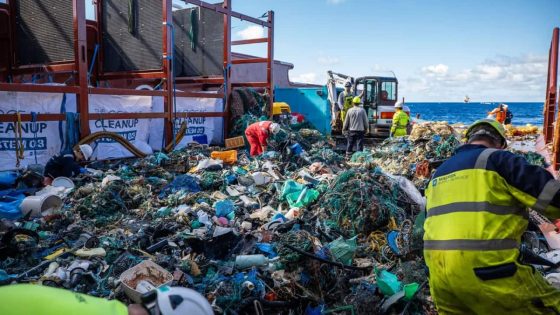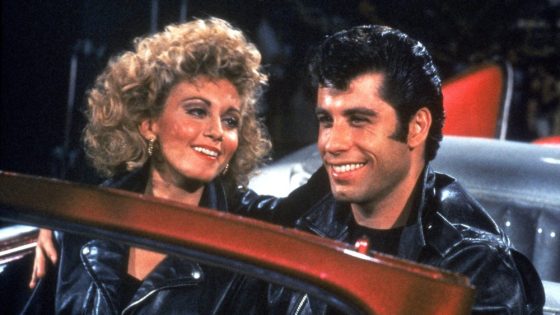Key Points
- The Great Pacific Garbage Patch is a trash vortex that spans from the West Coast of North America to Japan.
- An NGO has claimed that its technology could clean up the patch in ‘a manageable time and for a clear cost’.
- The organisation has said the problem could be solved in 5 years and would cost $6 billion.
A Dutch company claims to have found the solution to cleaning up the Great Pacific Garbage Patch — a trash vortex that spans from the West Coast of North America to Japan.
Not-for-profit The Ocean Cleanup has developed a GPS tracker that emulates how plastic moves in the ocean and a drone with artificial intelligence-powered cameras that can be used to detect pollution hotspots.
The organisation also uses an extraction technology known as ‘System 03’ to pull huge volumes of plastic from ocean gyres — large systems of circulating ocean currents formed by wind patterns and the Earth’s rotational force.
“Clean oceans can be achieved in a manageable time and for a clear cost,” CEO Boyan Slat said.
The Ocean Cleanup’s extraction technology known as ‘System 03’ consists of a floating barrier approximately 2.2 km long, which is towed between two slow-moving vessels. Credit: The Ocean Cleanup
The organisation has said that, according to its extrapolated data, the problem could be solved in five years — but it would carry a hefty price tag of $6 billion.
If done at today’s level of performance it would take 10 years and cost $11 billion.
Over the past three years, The Ocean Cleanup has reportedly removed more than 45,000 kilograms, or 0.5 per cent, of the waste in the Great Pacific Garbage Patch.
“We have shown the world that the impossible is now possible,” Slat said.
“The only missing thing is who will ensure this job gets done.”
Not identification, but intervention
The Ocean Cleanup’s outlined strategy involves intercepting plastic and garbage in rivers that flow out to the sea, and also cleaning up what has already been accumulated in the ocean using its identification technologies.
However, a hazardous materials expert said waste identification is not the problem.
“I don’t think it’s a breakthrough,” Trevor Thornton, senior lecturer at Deakin University, told SBS News.
“We know where all these areas are, it’s easy to identify the problem.
“It’s what we do with that information. It’s what governments do.”
While , they’re decentralised — and largely conducted by conservation groups and non-government organisations like The Ocean Cleanup, Thornton said.
“It’s been ad hoc. People have gone out and are using netting to scoop it up and put it on boats.”
“What it will take is a consolidated effort by governments.”
The question that remains: Who will take responsibility for a largely unseen plastic mass in international waters, over which no nation has jurisdiction?
In November, world leaders will meet in South Korea for the final round of talks to decide on a global plastics treaty.
The Great Pacific Garbage Patch
The Great Pacific Garbage Patch is the largest of five plastic accumulation zones in the world’s oceans.
The Ocean Cleanup has estimated that between 1.15 and 2.41 million tonnes of plastic are entering the ocean each year from river systems.
“It’s the outcome of humans not putting plastics in the right place and perhaps even overusing plastics,” Thornton said.
More than half of that plastic is less dense than ocean water and is resilient to breaking down or sinking to the bottom of the sea floor. It can also be transported over large distances.
The outcome is a trash vortex that covers an estimated surface area of 1.6 million square kilometres — almost as large as the state of Queensland.
Due to seasonal variability in winds and currents, the Great Pacific Garbage Patch’s location and shape are constantly changing.
Australia’s soft plastic problem
Australia produces more single-use plastic waste per capita than any other country in the world, apart from Singapore, according to the Minderoo Foundation.
While Australia has container deposit legislation, data shows that plastic littering is only increasing.
Plastics comprised 81 per cent of all Australian litter, according to Clean Up Australia’s Litter Report for the 2023 financial year. Compared to the 2022 report, soft plastics had increased to 34 per cent of all litter — a 9 per cent rise.
Meanwhile, data shows that national plastic consumption has continued to rise despite NSW and Victoria implementing bans against single-use plastics.
On a per capita basis, consumption increased by 60 per cent — from an estimated 92 kilograms per person in 2000, to 148 kilograms per person between 2020-21 — .
It also calculated the amount of plastic consumed in Australia will more than double by 2050.



